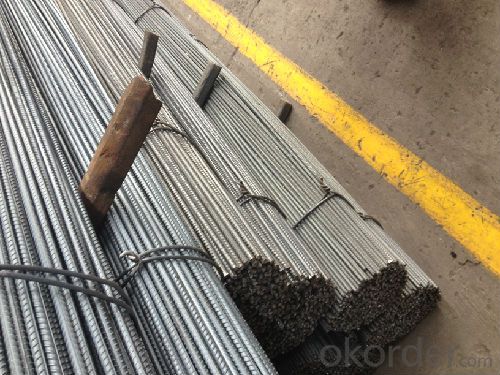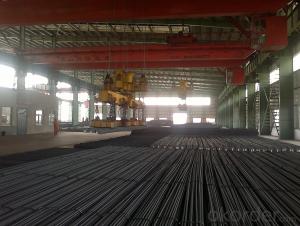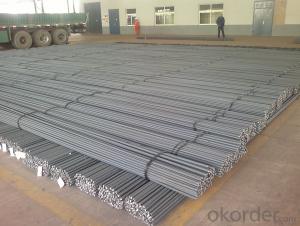Hot Rolled Deformed Steel Rebars ASTM, GB HRB400Cr, HRB500Cr
- Loading Port:
- Shanghai
- Payment Terms:
- TT or LC
- Min Order Qty:
- 100 m.t.
- Supply Capability:
- 200000 m.t./month
OKorder Service Pledge
OKorder Financial Service
You Might Also Like
OKorder is offering Hot Rolled Deformed Steel Rebars ASTM, GB HRB400Cr, HRB500Cr at great prices with worldwide shipping. Our supplier is a world-class manufacturer of steel, with our products utilized the world over. OKorder annually supplies products to African, South American and Asian markets. We provide quotations within 24 hours of receiving an inquiry and guarantee competitive prices.
Product Applications:
Hot Rolled Deformed Steel Rebars ASTM, GB HRB400Cr, HRB500Cr are ideal for structural applications and are widely used in the construction of buildings and bridges, and the manufacturing, petrochemical, and transportation industries.
Product Advantages:
OKorder's Hot Rolled Deformed Steel Rebars ASTM, GB HRB400Cr, HRB500Cr are durable, strong, and wide variety of sizes.
Main Product Features:
· Premium quality
· Prompt delivery & seaworthy packing (30 days after receiving deposit)
· Can be recycled and reused
· Mill test certification
· Professional Service
· Competitive pricing
Product Specifications:
Manufacture: Hot rolled
Grade: HRB400, HRB500 etc
Certificates: ISO, SGS, BV, CIQ
Length: 6m – 12m, as per customer request
Packaging: Export packing, nude packing, bundled
Deformed Steel Bar | ||
Diameter (MM) | Cross Sectional Area (MM2) | Theorectical Weight (KG/M) |
6 | 28.27 | 0.222 |
8 | 50.27 | 0.395 |
10 | 78.54 | 0.617 |
12 | 113.1 | 0.888 |
14 | 153.9 | 1.21 |
16 | 201.1 | 1.58 |
18 | 254.5 | 2 |
20 | 314.2 | 2.47 |
22 | 380.1 | 2.98 |
25 | 490.9 | 3.85 |
28 | 615.8 | 4.83 |
32 | 804.2 | 6.31 |
36 | 1018 | 7.99 |
40 | 1257 | 9.87 |
FAQ:
Q1: Why buy Materials & Equipment from OKorder.com?
A1: All products offered byOKorder.com are carefully selected from China's most reliable manufacturing enterprises. Through its ISO certifications, OKorder.com adheres to the highest standards and a commitment to supply chain safety and customer satisfaction.
Q2: How do we guarantee the quality of our products?
A2: We have established an advanced quality management system which conducts strict quality tests at every step, from raw materials to the final product. At the same time, we provide extensive follow-up service assurances as required.
Q3: How soon can we receive the product after purchase?
A3: Within three days of placing an order, we will arrange production. The normal sizes with the normal grade can be produced within one month. The specific shipping date is dependent upon international and government factors, the delivery to international main port about 45-60days.
Images:


- Q:What are the challenges associated with the installation of steel rebars?
- Some of the challenges associated with the installation of steel rebars include the difficulty in handling and positioning heavy steel bars, ensuring accurate placement and alignment, the need for skilled labor and expertise, managing reinforcement congestion in complex structural elements, and addressing potential corrosion issues. Additionally, coordination between different trades and adherence to safety protocols are crucial during the installation process.
- Q:What is the standard diameter of steel rebars?
- The standard diameter of steel rebars typically ranges from 6mm to 32mm.
- Q:What are the guidelines for splicing steel rebars in a structure?
- The guidelines for splicing steel rebars in a structure are as follows: 1. Ensure proper design: The first step is to have a detailed design of the structure, which includes the required length and location of rebar splices. The design should follow the applicable building codes and standards. 2. Use approved methods: It is crucial to use approved methods for splicing steel rebars. The most common methods include lap splicing, mechanical splicing, and welded splicing. The selected method should be in compliance with the design requirements and accepted industry practices. 3. Determine splice length: The splice length is determined based on the structural requirements and the type of rebar being used. It is recommended to consult the design engineer or refer to the code requirements to determine the appropriate splice length. 4. Prepare the rebars: Before splicing, rebars should be cleaned of rust, scale, oil, or any other contaminants that may affect the bond strength. The ends of the rebars should be clean and free from deformations or irregularities. 5. Splice location: The location of the splice is critical and should be as per the design specifications. Splices should not be placed in areas subjected to high stress or where they may affect the structural integrity of the member. 6. Reinforcement continuity: Splicing should maintain the continuity of reinforcement to ensure the structural integrity. Adequate overlap or connection strength should be achieved to transfer loads between the spliced rebars. 7. Proper installation: During splicing, it is important to follow proper installation procedures. This may include using appropriate splicing materials, ensuring correct alignment and fit, and applying the recommended torque or tension for mechanical splices. 8. Quality control and inspection: Regular inspections should be conducted during and after the splicing process to ensure compliance with the design and quality standards. This may involve visual inspection, non-destructive testing, or load testing as required. 9. Documentation and record-keeping: It is essential to maintain proper documentation of the splicing process, including details of the method used, splice length, location, and any deviations from the design. This documentation helps in ensuring traceability and accountability. 10. Compliance with codes and standards: Lastly, all splicing activities should comply with the relevant building codes, industry standards, and specifications. It is advisable to refer to the specific code requirements applicable to the region and seek professional advice if needed.
- Q:Are there any alternatives to steel rebars for reinforcement?
- Yes, there are several alternatives to steel rebars for reinforcement. Some commonly used alternatives include fiberglass rebar, carbon fiber rebar, and basalt rebar. These materials offer advantages such as higher tensile strength, corrosion resistance, and lighter weight compared to traditional steel rebars. However, the choice of reinforcement material depends on the specific project requirements and considerations.
- Q:Are there any specific safety measures to be taken while working with steel rebars?
- Yes, there are several specific safety measures to be taken while working with steel rebars. These include wearing appropriate personal protective equipment such as gloves, safety glasses, and steel-toed boots to protect against cuts, eye injuries, and foot injuries. It is also important to ensure that the work area is well-lit and free from tripping hazards. Workers should be trained in proper handling techniques to avoid strains and sprains, and should never carry or drag rebars by hand. Additionally, it is crucial to use the correct tools for cutting and bending rebars and to follow safe lifting practices to prevent back injuries. Regular inspections of the rebars for damage or defects should also be conducted to maintain a safe working environment.
- Q:What is the fatigue strength of steel rebars?
- The maximum stress level that steel rebars can endure without failing or developing cracks is known as their fatigue strength. This strength can vary depending on factors like the steel grade, manufacturing process, surface condition, and the specific design and loading conditions. Compared to other construction materials, steel rebars generally have high fatigue strength. The fatigue behavior of steel rebars is influenced by their mechanical properties, including yield strength, tensile strength, and ductility. Rebars with higher strength tend to have higher fatigue strength. To determine the fatigue strength of steel rebars, they are subjected to cyclic loading at specific stress amplitudes and frequencies in fatigue testing. The number of cycles required for failure or crack initiation is recorded, and the fatigue strength is determined based on the stress level at a specific number of cycles. Considering the fatigue strength of steel rebars is crucial in structural design, particularly in applications with cyclic loading or dynamic forces, such as bridges, buildings, and offshore structures. Engineers and designers must carefully analyze the loading conditions and choose rebars with appropriate fatigue strength to ensure the integrity and durability of the construction.
- Q:What is the yield strength of different grades of steel rebars?
- The yield strength of different grades of steel rebars can vary depending on the specific grade. Generally, rebars of grade 40 have a yield strength of 40,000 pounds per square inch (psi), grade 60 has a yield strength of 60,000 psi, and grade 75 has a yield strength of 75,000 psi. However, it is important to note that these values can differ slightly based on regional standards and specific manufacturer specifications.
- Q:Can steel rebars be used in decorative or artistic applications?
- Yes, steel rebars can be used in decorative or artistic applications. They can be shaped, bent, and welded to create unique designs and structures in various artistic forms such as sculptures, metal furniture, decorative panels, and architectural elements. The strength and durability of steel rebars make them suitable for both functional and aesthetic purposes in artistic projects.
- Q:What are the guidelines for the proper anchoring of steel rebars in columns?
- The guidelines for the proper anchoring of steel rebars in columns typically include ensuring that the rebars are adequately spaced, have sufficient embedment length, and are securely tied or welded to the column reinforcement. Additionally, the rebars should be properly aligned and centered within the column, and any required cover or protective measures should be implemented to prevent corrosion or damage. It is crucial to follow the specific design and code requirements for the project to ensure the structural integrity and safety of the reinforced concrete column.
- Q:What are the common myths and misconceptions about steel rebars?
- Addressing the importance of dispelling myths and misconceptions surrounding steel rebars is necessary for a better comprehension of their properties and applications. One prevalent myth is the ease with which steel rebars rust. Although steel can rust, rebars are typically manufactured using corrosion-resistant materials, such as epoxy-coated or galvanized steel. These coatings form a protective layer that prevents rusting, resulting in rebars that are highly durable and long-lasting, even in harsh environments. Another misconception is that larger rebars always offer stronger reinforcement. While the size or diameter of a rebar does contribute to its strength, it is not the sole determining factor. The quality or grade of the steel used, as well as its proper positioning within the concrete structure, are equally significant. Engineers meticulously calculate the necessary strength and spacing of rebars based on the specific load and structural requirements. Some individuals hold the belief that steel rebars are exclusively utilized in extensive construction projects. However, rebars are commonly employed in various construction applications, ranging from residential buildings to bridges and highways. Their versatility and strength make them indispensable components in reinforcing concrete structures of all sizes. There is also a misconception that steel rebars heighten the risk of electrical conductivity. While steel is an electricity conductor, the presence of rebars within a concrete structure does not significantly increase the likelihood of electrical hazards. Concrete acts as an insulator, and rebars are typically encased within it, thereby reducing the chances of contact with electrical currents. Finally, there exists a myth that steel rebars are expensive and unaffordable for most construction projects. In reality, the cost of rebars varies depending on factors such as grade, size, and quantity required. There are numerous options available to accommodate different budgets and project needs. Furthermore, the longevity and durability of steel rebars make them a cost-effective choice in the long term. In conclusion, dispelling myths and misconceptions surrounding steel rebars is crucial. Understanding their corrosion resistance, the role of size and placement, their versatility, the risks associated with electrical conductivity, and their cost-effectiveness will enable informed decision-making when it comes to reinforcing concrete structures.
1. Manufacturer Overview |
|
|---|---|
| Location | |
| Year Established | |
| Annual Output Value | |
| Main Markets | |
| Company Certifications | |
2. Manufacturer Certificates |
|
|---|---|
| a) Certification Name | |
| Range | |
| Reference | |
| Validity Period | |
3. Manufacturer Capability |
|
|---|---|
| a)Trade Capacity | |
| Nearest Port | |
| Export Percentage | |
| No.of Employees in Trade Department | |
| Language Spoken: | |
| b)Factory Information | |
| Factory Size: | |
| No. of Production Lines | |
| Contract Manufacturing | |
| Product Price Range | |
Send your message to us
Hot Rolled Deformed Steel Rebars ASTM, GB HRB400Cr, HRB500Cr
- Loading Port:
- Shanghai
- Payment Terms:
- TT or LC
- Min Order Qty:
- 100 m.t.
- Supply Capability:
- 200000 m.t./month
OKorder Service Pledge
OKorder Financial Service
Similar products
New products
Hot products
Related keywords




























